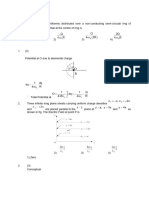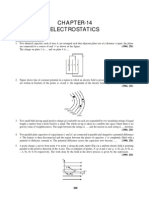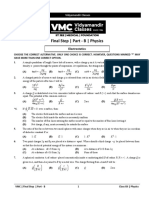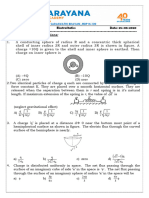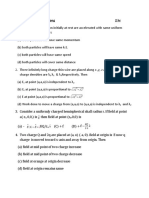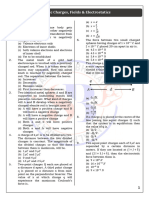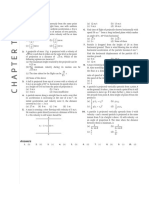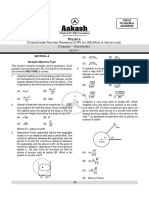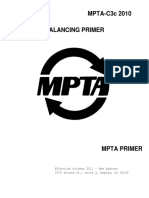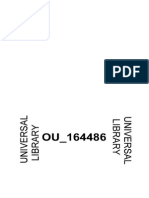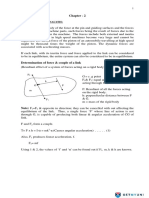0605251627046634
Uploaded by
prembarman1510605251627046634
Uploaded by
prembarman151E L E C T R O S TATI C S 77
M C Q Ty pe 1 Exercise 1 . 1
Only one option correct
1. Consider a neutral conducting sphere. A positive point charge is
5. A surface has the area vector A 2i 3 j m 2 . The flux of an
placed outside the sphere. The net charge on the sphere is then,
V
(a) negative and distributed uniformly over the surface of the electric field through it if the field is E 4i:
m
sphere
(a) 8 V-m (b) 12 V-m
(b) negative and appears only at the point on the sphere closest
(c) 20 V-m (d) zero
to the point charge
(c) negative and distributed non-uniformly over the entire surface 6. In figure a close surface encloses two of the four positively charged
particles. Which of the particles contribute to the electric field at
of the sphere
point P on the surface :
(d) zero.
2. There is a point charge +q inside a hollow sphere and a point (a) q1, q2
charge –q just outside its surface. The total flux passing through
the sphere (b) q1, q3
q q (c) q1, q2, q3
(a) (b)
0 0
(d) q1, q2, q3, q4
2q
(c) (d) zero. 7. Figure shows five charged lumps of plastic and an electrically
0 neutral metal coin. The close surface S is indicated in the figure.
3. Figure shows three electric field lines. If FA, FB and FC are the The net flux through the surface is :
forces on a test charge q at the positions A, B and C respectively, q1 q2 q3 q4 q5
then (a)
0
q1 q2 q3
(b)
0
q4 q5
(c)
0
(a) FA FB FC (b) FA FB FC (d) zero
8. The figure shows three situations in which a Gaussian cube sits in
(c) FA FB FC (d) FA FB FC
an electric field. The arrows and the values indicate the directions
4. In the figure the electric lines on the right have twice the separation of the field lines and the magnitudes (in N-m2/C) of the flux through
of those on the left. If a charge particle takes time t to move a
the six sides of each cube. The dotted arrows are of the hidden
distance x in left region, then it will take time to travel the same
faces. In which situation the cube enclose net positive charge :
distance in the right side region is :
t
(a) (b) t
2
(c) 2t (d) 2t (a) I (b) II
(c) III (d) none
Answer K ey 1 (d) 2 (b) 3 (c) 4 (c)
Sol. from page 107 5 (a) 6 (d) 7 (b) 8 (b)
78 ELECTRICITY & MAGNETISM
9. The figure shows three non conducting rods, one circular and two 13. The equipotential surfaces of a certain field are shown in figure. It
straight. Each has a uniform charge of magnitude Q along its top is know that V1 > V2. The direction of electric field is correctly
half and another along its bottom half. Which of them correctly represents in
represents the direction of field at point P :
(a) I (b) II
(c) III (d) I and II (a) (b)
10. A long, hollow conducting cylinder is kept coaxially inside another
long, hollow conducting cylinder of larger radius. Both the
cylinders are initially electrically neutral
(a) A potential difference appears between the two cylinders
when a charge density is given to the inner cylinder.
(b) A potential difference appears between two cylinders when (c) (d) none
a charge density is given to the outer cylinder.
(c) No potential difference appears between the two cylinders
when a uniform line charge is kept along the axis of the
cylinders. 14. The intensity of an electric field inside a capacitor is E. The work
(d) No potential difference appears between the two cylinders done to move a charge q in a closed rectangular loop is
when same charge density is given to both the cylinders.
11. A small metal ball is brought into contact alternatively with points
A, B and C of the charged body shown in figure. After each contact
the charge of the ball is determined approximately by touching it
against an electroscope. If qA, qB and qC are the charges, then
(a) E(2a + 2b) (b) E(2a)
(c) Ea (d) zero
15. Figure shows three paths along which we can move positively
charged sphere A closer to positively charged sphere B which is
(a) qA > qB > qC (b) qA < qB < qC fixed in a plane. If W1, W2 and W3 are the work done along the
(c) q A = q B, q C = 0 (d) qA = 0, qB = qC three respective paths, then
12. An uncharged metal ball is placed in the uniform electric field of
a plane capacitor. Which of them correctly represents the field
lines on the ball ?
(a) W1 > W2 > W3 (b) W1 > W3 > W2
(a) (b)
(c) W1 = W2 = W3 (d) none of these
16. Two equal positive charges are kept at points A and B. The electric
potential at the points between A and B (excluding these points) is
studied while moving from A to B. The potential
(c) (d) none (a) continuously increases (b) continuously decreases
(c) increases then decreases (d) decreases then increases
Answer Key 9 (a) 10 (a) 11 (a) 12 (c)
Sol. from page 107 13 (a) 14 (d) 15 (c) 16 (d)
E L E C T R O S TATI C S 79
17. Electric charges are distributed in a small volume. The flux of the 23. Two small spheres each having the charge +Q are suspended by
electric field through a spherical surface of radius 1 m surrounding insulating threads of length L from a hook. This arrangement is
the total charge is 100 V-m. The flux over the concentric sphere of taken in space where there is no gravitational effect, then the angle
radius 2 m will be between the two suspensions and the tension in each will be
(a) 25 V-m (b) 50 V-m
(c) 100 V-m (d) 200 V-m 1 Q2 1 Q2
(a) 180 , (b) 90 ,
18. Charges Q and –2Q are placed at some distance. The locus of 4 0 2L
2 4 0 L2
points in the plane of the charges where the potential is zero will
be
1 Q2 1 Q2
(a) a straight line (b) a circle (c) 180 , (d) 180 ,
4 0 2L2 4 0 L2
(c) a parabola (d) an ellipse
19. A conducting sphere S1 intersects a closed surface S2 as shown in 24. A charge q is placed at the centre of the line joining two equal
the figure. A positive charge q is placed at a point P. What is the charges Q. The system of the three charges will be in equilibrium,
value of electric flux through the surface S2 ? if q is equal to
Q Q
(a) (b)
2 4
Q Q
(c) (d)
4 2
25. The electric potential V at any point O (x, y, z all in metres) in
space is given by V=4x2 volt. The electric field at the point (1m, 0,
q 2m) in volt/metre is
(a) 0 (b)
0 (a) 8 along negative x–axis (b) 8 along positive x-axis
(c) 16 along negative x–axis (d) 16 along positive z-axis
q q
(c) (d) 26. Figure shows the electric lines of force emerging from a charged
0 0
body. If the electric field at A and B are EA and EB respectively and
20. A conducting spherical shell having inner radius a and outer radius if the displacement between A and B is r then
b carries a net charge Q. If a point charge q is placed at the centre
of this shell, then the surface charge density on the outer surface
of the shell is
Q q Q
(a) (b)
4 b2 4 b2
Q q
(c) (d) zero.
4 b2 (a) EA EB (b) EA EB
21. A loop of diameter d is rotated in a uniform electric field until the
position of maximum electric flux is found. The flux in this position EB EB
(c) EA (d) EA
is measured to be . What is the electric field strength ? r r2
4 2 27. In the electric field of a point charge q, a certain charge is carried
(a) (b) from point A to B, C, D and E. Then the work done
d2 d2
d2
(c) 2 (d)
d 4
22. Out of gravitational, electromagnetic, Vander Waals, electrostatic
and nuclear forces; which two are able to provide an attractive
force between two neutrons
(a) electrostatic and gravitational (a) is least along the path AB
(b) electrostatic and nuclear (b) is least along the path AD
(c) gravitational and nuclear (c) is zero along all the paths AB, AC, AD and AE
(d) some other forces like Vander Waals (d) is least along AE
Answer K ey 17 (c) 18 (a) 19 (b) 20 (c) 21 (a) 22 (c)
Sol. from page 107 23 (a) 24 (b) 25 (a) 26 (a) 27 (c)
80 ELECTRICITY & MAGNETISM
28. The magnitude of electric field intensity E is such that, an electron 35. A particle of mass m and charge q is placed at rest in a uniform
placed in it would experience an electrical force equal to its weight electric field E and then released. The kinetic energy attained by
is given by the particle after moving a distance y is
(a) qEy2 (b) qE2y
mg (c) qEy (d) q2Ey
(a) mge (b)
e 36. An electron of mass me initially at rest moves through a certain
distance in a uniform electric field in time t1. A proton of mass mp
e e2 also initially at rest takes time t2 to move through an equal distance
(c) (d) g in this uniform electric field. Neglecting the effect of gravity, the
mg m2 ratio of t2 / t1 is nearly equal to
29. A charged particle is free to move in an electric field. It will travel 1/ 2
(a) 1 (b) m p / me
(a) always along a line of force
(b) along a line of force, if its initial velocity is zero 1/ 2
(c) me / m p (d) 1836
(c) along a line of force, if it has some initial velocity in the
direction of an acute angle with the line of force 37. If a charged spherical conductor of radius 10 cm has potential V at
(d) none of the above a point distant 5 cm from its centre, then the potential at a point
distant 15 cm from the centre will be
30. Two point charges Q and –3Q are placed at some distance apart. If
the electric field at the location of Q is E then at the locality of – 1 2
(a) V (b) V
3Q, it is 3 3
(a) –E (b) E / 3 3
(c) –3E (d) –E / 3 (c) V (d) 3V
2
31. The number of electrons to be put on a spherical conductor of 38. Ten electrons are equally spaced and fixed around a circle of radius
radius 0.1m to produce an electric field of 0.036N/C just above its R. Relative to V=0 at infinity, the electrostatic potential V and the
surface is electric field E at the centre C are
(a) 2.7 × 105 (b) 2.6 × 105
5
(a) V 0 and E 0 (b) V 0 and E 0
(c) 2.5 × 10 (d) 2.4 × 105
32. Four equal charges Q are placed at the four corners of a square of (c) V 0 and E 0 (d) V 0 and E 0
each side is a. Work done in removing a charge –Q from its centre 39. The displacement of a charge Q in the electric field
to infinity is
E e1iˆ e2 ˆj e3kˆ is rˆ aiˆ bj . The work done is
2
2Q
(a) 0 (b)
4 0a (a) Q ae1 be2 (b) Q ae1
2
be2
2
2Q 2 Q2
(c) (d) (c) Q e1 e2 a2 b2 (d) Q e12 e22 a b
2 0a
0a
33. The magnitude of electric field E in the annular region of a charged 40. Three charges Q,+q and +q are placed at the vertices of a right-
cylindrical capacitor angled isosceles triangle as shown. The net electrostatic energy of
(a) is same throughout the configuration is zero if Q is equal to
(b) is higher near the outer cylinder than near the inner cylinder
(c) varies as 1 / r, where r is the distance from the axis
(d) varies as 1 / r2, where r is the distance from the axis
34. A metallic solid sphere is placed in a uniform electric field. The
lines of force follow the path(s) shown in figure as
q 2q
(a) (b)
1 2 2 2
(a) 1 (b) 2
(c) –2q (d) +q
(c) 3 (d) 4
Answer Key 28 (b) 29 (b) 30 (b) 31 (c) 32 (c) 33 (c) 34 (d)
Sol. from page 107 35 (c) 36 (b) 37 (b) 38 (b) 39 (a) 40 (b)
E L E C T R O S TATI C S 81
41. Figures below show regular hexagons, with charges at the vertices. 46. Equipotential surfaces associated with an electric field which is
In which of the following cases the electric field at the centre is increasing in magnitude along the x-direction are
not zero. (a) planes parallel to yz-plane
(b) planes parallel to xy-plane
(c) planes parallel to xz-plane
(d) coaxial cylinders of increasing radii around the x-axis
47. Figure shows three points A, B and C in a region of uniform electric
field E. The line AB is perpendicular and BC is parallel to the
field lines. Then which of the following holds good. Where VA,
VB and V C represent the electric potential at points A, B and C
respectively
(a) 1 (b) 2
(c) 3 (d) 4
42. The work done in bringing a 20 coulomb charge from point A to
point B for distance 0.2m is 2J. The potential difference between
the two points will be (in volt)
(a) 0.2 (b) 8 (a) VA = VB = VC (b) VA = VB > VC
(c) 0.1 (d) 0.4 (c) VA = VB < VC (d) VA > VB = VC
43. A thin spherical conducting shell of radius R has a charge q. 48. A charged ball B hangs from a silk thread S, which makes an angle
Another charge Q is placed at the centre of the shell. The with a large charged conducting sheet P, as shown in the figure.
R The surface charge density of the sheet is proportional to
electrostatic potential at a point P a distance from the centre
2 (a) sin
of the shell is
(b) tan
q Q 2 2Q
(a) (b) 4
4 0 R 0R (c) cos
2Q 2q 2Q q (d) cot
(c) 4 (d)
0R 4 0R 4 0R 4 0R
49. Two point charges + 8q and –2q are located at x = 0 and x = L
44. A hollow conducting sphere is placed in an electric field produced respectively. The location of a point on the x-axis at which the net
by a point charge placed at P as shown in figure. Let VA, VB, VC be electric field due to these two point charges is zero
the potentials at point A, B and C respectively. Then
(a) 8L (b) 4L
L
(c) 2L (d)
4
50. For a given surface the Gauss's law is stated as E . dA 0 . From
this we can conclude that
(a) VC VB (b) VB VC
(a) E is necessarily zero on the surface
(c) VA VB (d) VA VC
(b) E is perpendicular to the surface at every point
45. Electric potential of earth is taken to be zero because earth is a
(c) The total flux through the surface is zero
good
(a) insulator (b) conductor (d) The flux is only going out of the surface
(c) semiconductor (d) dielectric
Answer K ey 41 (b) 42 (c) 43 (d) 44 (d) 45 (b)
Sol. from page 107 46 (a) 47 (b) 48 (b) 49 (c) 50 (c)
82 E L E C T R I C IT Y & M A G N E TI S M
51. Electric charge is uniformly distributed along a long straight wire 55. If on the concentric hollow spheres of radii r and R(> r) the charge
of radius 1mm. The charge per cm length of the wire is Q coulomb. Q is distributed such that their surface densities are same then the
Another cylindrical surface of radius 50 cm and length 1m potential at their common centre is
symmetrically encloses the wire as shown in the figure. The total
Q R2 r2 QR
electric flux passing through the cylindrical surface is
(a) (b)
4 0 R r R r
Q
(a)
0 Q R r
(c) zero (d)
2
100Q 4 0 R r2
(b)
0 56. Three positive charges of equal value q are placed at the vertices
of an equilateral triangle. The resulting lines of force should be
10Q sketched as in
(c)
0
100Q
(d)
0
(a) (b)
52. q1, q2, q3 and q4 are point charges located at points as shown in
the figure and S is a spherical Gaussian surface of radius R. Which
of the following is true according to the Gauss's law?
(c) (d)
57. A metallic shell has a point charge q kept inside its cavity. Which
one of the following diagrams correctly represents the electric lines
q1 q2 q3 of forces
(a) E1 E2 E3 .dA
2 0
q1 q2 q3
(b) E1 E2 E3 E4 .dA (a) (b)
0
q1 q2 q3 q4
(c) E1 E2 E3 .dA
0
(d) none of the above
53. If the electric flux entering and leaving an enclosed surface
respectively is 1 and 2 the electric charge inside the surface will (c) (d)
be
(a) ( 1 + 2) 0 (b) ( 2 – 1) 0
58. Two point charges +q and –q are held fixed at (–d, 0) and (d, 0)
(c) ( 1 + 2) 0 (d) ( 2 + 1) 0
respectively of a (x, y) coordinate system. Then
54. An electric line of force in the xy plane is given by equation
x2 + y2 = 1. A particle with unit positive charge, initially at rest at (a) E at all points on the y-axis is along iˆ
the point x = 1, y = 0 in the xy plane (b) The electric field E at all points on the x-axis has the same
(a) not move at all direction
(b) will move along straight line (c) Dipole moment is 2qd directed along iˆ
(c) will move along the circular line of force (d) Work has to be done in bringing a test charge from infinity
to the origin
(d) information is insufficient to draw any conclusion
Answer K ey 51 (b) 52 (b) 53 (b) 54 (c)
Sol. from page 107 55 (d) 56 (c) 57 (c) 58 (a)
ELECTROSTATICS 83
59. A charged particle q is shot towards another charged particle Q 63. A point charge q is at a distance d from a conducting plane and is
which is fixed, with a speed v. It approaches Q upto a closest to be moved infinitely away from the plane. The energy required
distance r and then returns. If q were given a speed 2v, the closest to achieve this is :
distances of approach would be
1 q2 1 q
(a) (b) 4 d
4 0 d 0
(a) r (b) 2r
(c) r / 2 (d) r / 4 1 q 1 q2
60. Point charge q moves from point P to point S along the path PQRS (c) 4 2d (d)
0 4 0 4d
(figure shown) in a uniform electric field E pointing coparallel to
the positive direction of the x-axis. The coordinates of the points 64. Five balls numbered 1 to 5 are suspended using separate threads.
P,Q,R and S are (a, b, 0), (2a, 0, 0), (a, –b, 0) and (0, 0, 0) Pairs (1, 2), (2, 4), (4, 1) show electrostatic attraction, while pairs
respectively. The work done by the field in the above process is (2, 3) and (4, 5) show repulsion. Therefore ball 1 must be :
given by the expression (a) positively charged (b) negatively charged
(c) neutral (d) made of metal
65. A and B are two concentric spheres. If A is given a charge Q while
B is earthed as shown in figure :
B
+ + + +A
+ +
+ +
(a) qEa (b) –qEa + +
++ + +
2
(c) qEa 2 (d) qE 2a b2
61. The variation of potential with distance R from a fixed point is as
shown below. The electric field at R = 5m is
(a) the charge density of A and B are same
(a) 2.5 volt / m (b) the field inside and outside A is zero
(c) the field between A and B is not zero
(b) –2.5 volt / m
(d) the field inside and outside B is zero
(c) 2 / 5 volt / m 66. Under the influence of the Coulomb field of charge + Q, a charge
–q is moving around it in an elliptical orbit. Find out the correct
(d) –2 / 5 volt / m statement(s)
(a) the angular momentum of the charge –q is constant
62. The electric field due to a uniformly charged sphere of radius R as
a function of the distance from its centre is represented graphically (b) the linear momentum of the charge –q is constant
by (c) the angular velocity of the charge –q is constant
(d) the linear speed of the charge –q is constant
67. A solid spherical conductor of radius R has a spherical cavity of
radius a (a < R) at its centre. A charge + Q is kept at the centre.
(a) (b) The charge at the inner surface, outer and at a position r (a < r <
R) are respectively
(a) + Q, – Q, 0 (b) – Q, + Q, 0
(c) 0, – Q, 0 (d) + Q, 0, 0
68. One metallic sphere A is given positive charge whereas another
(c) (d) identical metallic sphere B of exactly same mass as of A is given
equal amount of negative charge. Then
(a) mass of A and mass of B still remain equal
(b) mass of A increases
(c) mass of B decreases
(d) mass of B increases
Answer Key 59 (d) 60 (b) 61 (a) 62 (b) 63 (d)
Sol. from page 107 64 (c) 65 (c) 66 (a) 67 (b) 68 (d)
84 E L E C T R I C IT Y & M A G N E TI S M
69. Three charges are placed at the vertices of an equilateral triangle
of side 'a' as shown in the following figure. The force experienced 2me
(a) 1 (b)
by the charge placed at the vertex A in a direction normal to BC is m
+Q A me me
(c) (d)
m 2m
2
77. The dimension of (1/2) 0E ( 0 : permittivity of free space; E
–Q +Q : Electric field ) is
B C
(a) [MLT ] (d) [ML2T ]
(c) [ML 1T 2] (d) [ML2T 1]
(a) Q 2 /(4 0a
2
) (b) –Q 2 /(4 0a
2
) 78. Two spheres A and B of radius 'a' and 'b' respectively are at same
electric potential. The ratio of the surface charge densities of A
(c) zero (d) Q 2 /(2 0a
2
) and B is
70. An infinite number of charges, each of charge 1µC, are placed on a b
the x-axis with co-ordinates x = 1, 2, 4, 8, ...... . If a charge of 1 C (a) (b)
b a
is kept at the origin, then what is the net force acting on 1 C charge
(a) 9000 N (b) 12000 N
a2 b2
(c) 24000 N (d) 36000 N (c) (d)
71. Gauss law of gravitation is b2 a2
79. A ball of mass 1 g and charge 10–8C moves from a point A, where
(a) g .dA m (b) g .dA Gm
potential is 600 volt to the point B where potential is zero. Velocity
of the ball at the point B is 20 cm/s. The velocity of the ball at the
(c) g .dA – 4G m (d) all the above point A will be
72. There is an electric field E in x-direction. If the work done on (a) 22.8 cm/s (b) 228 cm/s
moving a charge 0.2 C through a distance of 2m along a line making (c) 16.8 m/s (d) 168 m/s
an angle 60° with the x-axis is 4.0 J, what is the value of E 80. The figure shows the path of a positively charged particle 1 through
a rectangular region of uniform electric field as shown in the figure.
(a) 3 N/C (b) 4 N/C What is the direction of electric field and the direction of particles
2, 3 and 4 ?
(c) 5 N/C (d) 20 N / C.
Top
73. Two charge + q and – q are situated at a certain distance. At the 2– +3
point exactly midway between them –4
1+
(a) electric field and potential both are zero Down
(b) electric field is zero but potential is not zero
(a) Top, down, top, down (b) Top, down, down, top
(c) electric field is not zero but potential is zero
(c) Down, top, top, down (d) Down; top, down, down
(d) neither electric field nor potential is zero
81. The spatial distribution of the electric field due to charges (A, B)
74. Two metal pieces having a potential difference of 800V are 0.02 is shown in figure. Which one of the following statements is
m apart horizontally. A particle of mass 1.96 × 10–15kg is suspended correct?
in equilibrium between the plates. If e is the elementary charge,
then charge on the particle is
(a) e (b) 3e
(c) 6e (d) 8e A B
75. Two spheres of radii a and b respectively are charged and joined
by a wire. The ratio of electric field of the spheres is
(a) a /b (b) b /a
(a) A is +ve and B –ve and |A| > |B|
(c) a2 / b2 (d) b2 / a2 (b) A is –ve and B + ve; | A | = | B |
76. The ratio of momenta of an electron and an -particle which are (c) Both are +ve but A > B
accelerated from rest by a potential difference of 100 volt is
(d) Both are – ve but A > B
Answer K ey 69 (c) 70 (b) 71 (c) 72 (d) 73 (c) 74 (b) 75 (b)
Sol. from page 107 76 (d) 77 (c) 78 (b) 79 (a) 80 (a) 81 (a)
ELECTROSTATICS 85
82. Charges are placed on the vertices of a square as shown. Let E be
the electric field and V the potential at the centre. If the charges on z
A and B are interchanged with those on D and C respectively,
then. (a,0,a) (a,a,a)
q q
A B
y
(0,0,0) (0,a,0)
x
D C
–q –q
(a) 2E0a2 (b) 2E0a 2
(a) E remains unchanged, V changes
E0 a 2
(b) Both E and V change (c) E0 a2 (d)
2
(c) E and V remains unchanged
88. A wooden block performs SHM on a frictionless surface with
(d) E changes, V remains unchanged frequency, 0. The block carries a charge + Q on its surface. If
83. An electric dipole of moment p is placed normal to the lines of now a uniform electric field E is switched-on as shown, then the
SHM of the block will be
force of electric intensity E , then the work done in deflecting it
through an angle of 180° is
(a) pE (b) + 2pE E
(c) – 2pE (d) zero
84. The value of electric potential at any point due to any electric +Q
dipole is
(a) of the same frequency and with shifted mean position.
p r p r (b) of the same frequency and with the same mean position
(a) k. (b) k.
r2 r3 (c) of changed frequency and with shifted mean position.
(d) of changed frequency and with the same mean position.
p.r p.r 89. Two thin wire rings each having a radius R are placed at a distance
(c) k. (d) k.
r 2 r3 d apart with their axes coinciding. The charges on the two rings
85. Gauss’s law should be invalid if are + Q and – Q. The potential difference between the centres of
(a) there were magnetic monopoles the two rings is
(b) the inverse square law were not exactly true (a) zero
(c) the velocity of light were not a universal constant
Q 1 1
(d) none of these (b)
86. A square surface of side L meters is in the plane of the paper. A 4 0 R R2 d2
uniform electric field E (volt/m), also in the plane of the paper, is 2
(c) QR / 4 0d
limited only to the lower half of the square surface, (see figure).
The electric flux in SI units associated with the surface is
Q 1 1
(d) 2 R 2
0 R d2
90. Two infinitely long parallel conducting plates having surface charge
densities + and – respectively, are separated by a small distance.
E
The medium between the plates is vacuum. If 0 is the dielectric
permittivity of vacuum, then the electric field in the region between
the plates is
(a) zero (b) EL2
(c) EL2 / 2 0 (d) EL2/ 2 V/m
(a) 0 V/m (b) 2 0
87. Consider an electric field E E0 xˆ where E0 is a constant. The
flux through the shaded area (as shown in the figure) due to this 2
(c) V/m (d) V/m
field is 0 0
Answer Key 82 (d) 83 (d) 84 (d) 85 (b) 86 (a)
Sol. from page 107 87 (c) 88 (a) 89 (d) 90 (c)
86 ELECTRICITY & MAGNETISM
91. The figure shows a charge q placed inside a cavity in an uncharged (b) only induced charge on inner surface will redistribute
conductor. Now if an external electric field is switched on then : (c) both induced charge on outer and inner surface will
redistribute.
(d) force on charge q placed inside the cavity will change
C 92. A given charge is situated at a certain distance from an electric
q dipole in the end-on position, experiences a force F. If the dis-
tance of the charge is doubled, the force acting on the charge will
be
(a) 2F (b) F / 2
(a) only induced charge on outer surface will redistribute.
(c) F / 4 (d) F / 8
Answer Key 91 (a) 92 (d)
Sol. from page 107
Level -2
Only one option correct 3. Two small identical metal balls of radius r are at a distance a from
q q 2q each other and are charged, one with a potential V1 and the other
1. Consider a system of three charges , and placed at with a potential V2. The charges on the balls are :
3 3 3
points A, B and C, respectively, as shown in figure. Take O to be (a) q1 V1a, q2 V2a
the circle of radius R and angle CAB = 60°. Choose the correct
one: (b) q1 V1r , q2 V2r
V1 V2 V1 V2
(c) q1 a, q2 r
2 2
r r
(d) q1 rV2 aV1 , q2 rV1 aV2
a a
4. The distance between the plates of a charged plate capacitor
disconnected from the battery is 5 cm and the intensity of the field
in it is E = 300 V/cm. An uncharged metal bar 1 cm thick is
q
(a) The electric field at point O is directed along the introduced into the capacitor parallel to its plates. The potential
8 0 R2 difference between the plates now is :
negative x-axis. (a) 1500 V (b) 1200 V
(b) The potential energy of the system is zero.
(c) The magnitude of the force between the charges at C and B (c) 900 V (d) zero.
5. Three infinite long charged sheets of charge densities – , –2
q2 and are placed parallel to xy-plane at z = 0, z = a, z = 3a. Electric
is
54 0 R2 field at point P is
q
(d) The potential at point O is 12
0 R
2. Figure shows an electric quadrupole, with quadrupole moment
(Q = 2q 2). The electric field at a distance from its centre at the
axis of the quadrupole is given by
2 2
(a) k̂ (b) k̂
0 0
1 Q 1 2Q
(a) (b)
4 0 r4 4 0 r4 4
k̂
4
k̂
(c) (d)
0 0
1 3Q
(c) (d) none
4 0 r4
Answer Key 1 (c) 2 (c) 3 (d)
Sol. from page 110 4 (b) 5 (d)
E L E C T R O S TATI C S 87
L d d
6. Figure shows an imaginary cube of edge . An uniformly charged (a) x (b) x
2 2 2
rod of length L moves towards left at a small but constant speed v.
d d
At t = 0, the left end just touches the centre of the face of the cube (c) x (d) x
opposite it. Which of the graphs shown in the figure represents 2 2 3 2
the flux of the electric field through the cube as the rod goes through 11. Two plane metal plates are placed parallel to each other, one carries
it a surface density + and the other –2 . A third plate is placed
between them and earthed. The charge density on the left face of
this plate is :
(a) +
(b) –
(c) +2
(d) zero
(a) I (b) II 12. Four similar point charges q are located at the vertices of a
(c) III (d) IV tetrahedron with an edge a. The energy of the interaction of charges
7. A sphere of radius 2R has a uniform charge density . The is :
difference in the electric potential at r = R and r = 0 from the
centre is :
R2 2 R2
(a) (b)
0 0
R2 R2
(c) (d)
3 0 6 0
8. A sphere of radius R carries charge density proportional to the 6q2 4q 2
(a) (b)
square of the distance from the centre such that = CR2, where C 4 0 a 4 0 a
is a positive constant. At a distance R/2 from the centre, the
magnitude of the electric field is 3q 2 q2
(c) (d)
4 0 a 4 0 a
CR3 CR3
(a) (b) 13. Two charges are at a distance d apart. If a copper plate (conducting
20 0 10 0
d
medium) of thickness is placed between them, the effective
2
CR3
(c) (d) none of these force will be
5 0 (a) 2F (b) F/2
9. The work done in moving an electron of charge e and mass m (c) 0 (d) 2F
from A to B along the circular path (shown in figure) in the vertical 14. Two spherical conductors B and C having equal radii and carrying
plane in the field of charge Q is equal charges in them repel each other with a force F when kept
(a) 2 mg apart at some distance. A third spherical conductor having same
2Qe radius as that of B but uncharged is brought in contact with B,
(b) then brought in contact with C and finally removed away from
r
both. The new force of repulsion between B and C is
2Qe (a) F / 4 (b) 3F / 4
(c) 2mgr (c) F / 8 (d) 3F / 8
r
(d) zero 15. Electric potential at any point is V 5x 3 y 15 z , then the
10. Two particles A and B having equal charges are placed at a distance magnitude of the electric field is
d apart. A third charged particle placed on the perpendicular (a) 3 2 (b) 4 2
bisection of AB at distance x. The third particle experiences
maximum force when (c) 5 2 (d) 7
Answer K ey 6 (d) 7 (d) 8 (d) 9 (a) 10 (c)
Sol. from page 110 11 (b) 12 (a) 13 (c) 14 (d) 15 (d)
88 E L E C T R I C IT Y & M A G N E TI S M
16. Four point +ve charges of same magnitude (Q) are placed at four 20. Charge q is uniformly distributed over a thin half ring of radius R.
corners of a rigid square frame as shown in figure. The plane of The electric field at the centre of the ring is
the frame is perpendicular to z-axis. If a –ve point charge is placed
at a distance z away from the above frame (z < < L) then q q
(a) 2 2
(b) 2 2
2 0R 4 0R
q q
(c) (d)
2 2
4 0R 2 0R
21. Two equal point charges are fixed at x = –a and
x = + a on the x-axis. Another point charge Q is placed at the
origin. The change in the electric potential energy of Q, when it is
displaced by a small distance x along the x-axis, is approximately
(a) –ve charge oscillates along the z-axis.
(b) it moves away from the frame proportional to
(c) it moves slowly towards the frame and stays in the plane of (a) x (b) x2
the frame (c) x3 (d) 1/x
(d) it passes through the frame only once.
22. Four charges equal to –Q are placed at the four corners of a square
17. Two identical thin rings each of radius R meters are coaxially placed
at a distance R meters apart. If Q1 coulomb and Q2 coulomb are and a charge q is at its centre. If the system is in equilibrium the
respectively the charges uniformly spread on the two rings, the value of q is
work done in moving a charge q from the centre of one ring to that Q Q
of other is (a) 1 2 2 (b) 1 2 2
4 4
q Q1 Q2 2 1
(a) zero (b) Q Q
2.4 (c) 1 2 2 (d) 1 2 2
0R 2 2
23. Two concentric conducting thin spherical shells A, and B having
q 2 Q1 Q2 q Q1 Q2 2 1 radii rA and rB ((rB > rA) are charged to QA and –QB (|QB| > |QA|).
(c) (d) The electric field along a line (passing through the centre) is
4 0R 2.4 0R
18. A charge + q is fixed at each of the points x x0 , x 3x0 ,
x 5 x0 ....... infinite, on the x-axis and a charge – q is fixed at
(a) (b)
each of the points x 2 x0 , x 4 x0 , x 6 x0 ...... infinite. Here x0
is a positive constant. Take the electric potential at a point due to
a charge Q at a distance r from it to be Q / (4 0r). Then, the
potential at the origin due to the above system of charges is
q
(a) 0 (b)
8 0 x0 ln 2
(c) (d)
q ln 2
(c) (d)
4 0 x0
19. A non-conducting ring of radius 0.5 m carries a total charge of
1.11×10 –10C distributed non-uniformly on its circumference 24. A particle of charge -q and mass m moves in a circular orbit of
radius r about a fixed charge + Q. The relation between the radius
producing an electric field E everywhere in space. The value of of the orbit r and the time period T is :
0
the line integral ( = 0 being centre of the ring) in Qq Qq
E.d (a) r T2 (b) r3 3
T2
2
16 0 m 16 0 m
volts is
(a) + 2 (b) –1 Qq Qq
(c) r2 T3 (d) r2 3
T3
(c) –2 (d) zero 3
16 0 m 4 0 m
Answer K ey 16 (a) 17 (b) 18 (d) 19 (a) 20 (a)
Sol. from page 110 21 (b) 22 (b) 23 (a) 24 (b)
E L E C T R O S TATI C S 89
25. A thin glass rod is bent into a semicircular shape of radius R. A
kq kq
charge + Q is uniformly distributed along the upper half and a (a) (b)
r r'
charge – Q is uniformly distributed along the lower half as shown
in the figure. The electric field at the centre P, is : kq kq kq
(c) – (d)
Q r r' CP
(a) 4 2 +Q 29 A disk of radius a / 4 having a uniformly distributed charge 6 C is
0R
+
+ placed in the x - y plane with its centre at (–a / 2, 0, 0). A rod of
Q + length a carrying a uniformly distributed charge 8 C is placed on
(b) 2 2
the x - axis from x = a /4 to x = 5a / 4. Two point charges – 7 C and
0R + P
- 3 C are placed at (a / 4, – a /4, 0) and (– 3a /4, 3a / 4, 0), respectively.
Q - R
(c) Consider a cubical surface formed by six surfaces x = a / 2,
(4 2 -
0 R) -
–Q y = a / 2, z = a / 2. The electric flux through this cubical
Q surface is
(d) 2 2
0R
y
26. A bullet of mass m and charge Q is fired towards a solid uniformly
charged sphere of radius R and total charge Q. If it strikes the
surface of sphere with speed v, the minimum speed v so that it can
penetrate through the sphere :
x
Q Q
(a) 2 mR (b) 6 mR
0 0
Q 3Q
(c) 4 mR (d) 4 mR
0 0
27. A plastic disk is charged on one side with a uniform surface charge –2C 2C
(a) (b)
density and then three quadrant of the disk are removed. The 0
0
remaining quadrant is shown in figure, with V = 0 at infinity, the
potential due to the remaining quadrant at point P is : 10C 12C
(c) (d)
0 0
P 30. Consider the shown uniform solid insulating sphere with a short
r and light electric dipole of dipole moment p j (embedded at its
R centre) placed at rest on a horizontal surface. An electric field Ei
is suddenly switched on in the region such that the sphere instantly
begins rolling without slipping. Speed of the sphere when the
dipole moment becomes horizontal for the first time is (m = Mass
of the sphere)
(a) [( r 2 R)1/ 2 r] (b) [R r ] y
2 0 2 0
(c) [(r 2 R 2 )1/ 2 r] (d) none of these p
8 0
28. A neutral conducting spherical shell is kept near a charge q as x
shown. The potential at point P due to the induced charges is : 5 pE 10 pE
(a) (b)
m 7m
q r C 5 pE
r P (c) (d) zero
2m
Answer K ey 25 (d) 26 (c) 27 (c)
Sol. from page 110 28 (c) 29 (a) 30 (b)
90 ELECTRICITY & MAGNETISM
31. Two small balls of mass M each carrying charges + Q and
– Q, connected by a massless rigid non-conducting rod of length 2
(a) (b)
0 0
L lie along x-axis as shown. A uniform electric field E 3kˆ 3 ˆj
has been switched on. The angular velocity vector of the dipole
0 0
when dipole moment aligns with the electric field is (c) (d)
2
y 35. In figure + Q charge is located at one of the edge of the cube.
Then electric flux through cube due to + Q charge is
+Q
x
–Q +Q a
a
a
z
Q Q
3 2 Q 6 2Q (a) (b) 2
(a) ˆj kˆ (b) ˆj kˆ 0 0
2 ML ML
Q Q
(c) 4 (d) 8
3 2 Q ˆj kˆ 3 2 Q ˆj kˆ 0 0
(c) (d)
ML ML 36. If an insulated non-conducting sphere of radius R has charge
density . The electric field at a distance r from the centre of sphere
32. The grid (each square of 1m × 1m), represents a region in space
(r < R) will be
containing a uniform electric field. If potentials at point O, A, B,
R r
C, D, E, F, G, H are respectively 0, –1, –2, 1, 2, 0, –1, 1 and 0 (a) (b)
3 0 0
volts. Find the electric field intensity.
r 3 R
y (c) (d)
3 0 0
37. Two insulating plates are both uniformly charged in such a way
D G H that the potential difference between them is V2 – V1= 20V. (i.e.
plate 2 is at a higher potential). The plates are separated by d = 0.1
C E F
m and can be treated as infinitely large. An electron is released
x
O A B from rest on the inner surface of plate 1. What is its speed when it
hits plate 2 (e = 1.6 × 10–19 C, me = 9.11 × 10–31 kg)?
1m
(a) (iˆ ˆj )V / m (b) (iˆ ˆj )V / m
(c) (–iˆ ˆj )V / m (d) (–iˆ ˆj )V / m 0.1 m
33. Three concentric metallic spherical shells of radii R, 2R, 3R, are
given chargesQ1, Q2, Q3, respectively. It is found that the surface
charge densities on the outer surfaces of the shells are equal. Then,
the ratio of the chrges given to the shells, Q1: Q2, Q3, is
1 2
(a) 1:2:3 (b) 1:3:5 (a) 7.02 × 1012 m/s (b) 1.87 × 106 m/s
(c) 1:4:9 (d) 1 : 8 : 18 (c) 32 × 10–19 m/s (d) 2.65 ×106 m/s
0
38. The potential at a point x (measured in m) due to some charges
34. A solid sphere of radius R1 and volume charge density is situated on the x-axis is given by V(x) = 20 / (x2 – 4) volts. The
r
electric field E at x = 4 m is given by
enclosed by a hollow sphere of radius R2 with negative surface
(a) 5/3 volt / m and in the – ve x direction
charge density , such that the total charge in the system is zero.
(b) 5/3 volt / m and in the + ve direction
0 is a positive constant and r is the distance from the centre of
the sphere. The ratio R2 / R1 is (c) 10/9 volt / m and in the – ve direction
(d) 10/9 volt / m and in the + ve direction
Answer Key 31 (b) 32 (b) 33 (b) 34 (c)
Sol. from page 110 35 (c) 36 (c) 37 (d) 38 (d)
E L E C T R O S TATI C S 91
39. The adjacent diagram shows a charge +Q held on an insulating 43. A block of mass m and charge q is connected to a point O with
support S and enclosed by a hollow spherical conductor represents help of an inextensible string. The system is on a horizontal table.
the centre of the spherical conductor and P is a point such that An electric field is switched on in direction perpendicular to string.
What will be tension in string when it become parallel to electric
OP = x and SP = r. The electric field at point P will be
field?
Charge + Q on
insulating support
S r
O x P
E
SP = r O
OP = x
qE
(a) (b) 3qE
2
Q Q 3qE
qE
(a) 2 (b) 2 (c) (d)
4 0x 4 0r 5
44. Two short dipoles of dipole moment p are placed at two corners of
(c) 0 (d) none of the above
a squares as shown in the figure. What is the ratio of magnitudes
40. Two equal charges q of opposite sign separated by a distance 2a of electric field at two points. O & A?
constitute an electric dipole of dipole moment p. If P is a point at
a distance r from the centre of the dipole and the line joining P
centre of the dipole to this point makes an angle with the axis of
the dipole, then the potential at P is given by (r > > 2a) (where
p = 2qa) (where p = 2 qa) O
P
p cos p cos
(a) V 2 (b) V A
4 0r 4 0r
(a) 2 (b) 2 2
p sin p cos
(c) V (d) V 2 (c) 1 (d) 2
4 0r 2 0r
45. A point shell of radius a and centre (0, 0, 0). What is flux linked to
41. A spherical portion has been removed from a solid sphere having hemispherical surface? x2 + y2 + z2 = 4a2 & z > 0 ?
a charge distributed uniformly in its volume in the figure. The q q
electric field inside the emptied space is (a) 2 (b)
0 0
q
(c) less than 2 (d) zero
0
46. Two pith balls having charge 3q and 2q are placed at distance of a
from each other. For what value of charge transferred from 1st
(a) zero everywhere (b) non-zero and uniform ball to 2nd ball, force between balls becomes maximum?
(c) non-uniform (d) zero only at its centre
q 5q
42. A solid sphere of radius R has a charge Q distributed in its volume (a) (b)
2 2
with a charge density = kra, where k and a are constants and r is
(c) 7q (d) q
R 1 47. Two concentric spherical shells of radii a & 1.2 a have charges
the distance from its centre. If the electric field at r = is times
2 8 + Q and –2 Q respectively. At what distance from centres potential
will be same as that of centre?
that at r = R, the value of a is.
(a) 2 a (b) 1.5 a
(a) 3 (b) 5
(c) 2.5 a (d) 3 a
(c) 2 (d) both (a) and (b)
Answer K ey 39 (a) 40 (a) 41 (b) 42 (c) 43 (b)
Sol. from page 110 44 (b) 45 (a) 46 (a) 47 (b)
92 ELECTRICITY & MAGNETISM
48. A conduction rod of length l rotates about its one end with angular 53. Three charges each of value Q are placed at points A (–K, 0), O
velocity . Potential difference between A and B is (M & e = mass
(0, 0) and b (0, K). If force on point charge at A is aiˆ bjˆ then
and charge of electron)
force on point charge at B is
A B
/2 (a) aiˆ bjˆ (b) bjˆ ajˆ
M 2 2
l 3M 2 2
l (c) biˆ ajˆ (d) ajˆ biˆ
(a) (b)
e 4e
54. A charged particle enters at point A and comes out from B. Its
velocity makes angle & with electric field at these two points.
3 M 2 l2
(c) (d) zero Ratio of kinetic energy of changed particle at these two points
8 e
will be
49. There is a dielectric rod between charges q1 and q2. If this rod is
removed, then net force on q1.
(a) increases
– – – – –
B
(b) decreases q1 q2
(c) remains same
(d) both (1) & (2) are possible, depending on the nature of A
charges + + + + +
50. Surface charge densities of two concentric spheres of radii, R1
and R2 are + 1 and – 2. Suppose E1 is field at distance r (such
that R1 < r < R2). Now if two spheres are connected by a thin wire, sin 2 sin 2
(a) 2 (b)
E2 sin sin 2
field at same point is E2, where is
E1
cos 2 cos 2
R1 R2 (c) 2 (d)
(a) (b) cos cos 2
R1 R2 R1 R2
(c) zero (d) infinite 55. If a point charge is placed at vertex of cube then, flux linked to
surface shaded in figure
51. If electric field between plates of a parallel plate capacitor is 2 N/
C and charge on two plates are 10 C and 3 C then force on one of
the plates is q
(a) 20 N (b) 13 N
60 7
(c) N (d) N
7 2
52. A solid sphere having uniform charge density and radius R is
R
show in figure. A spherical cavity of radius is hollowed out. q q
2
(a) 8 (b) 3
What is potential of O?(Assuming potential of infinity to be zero) 0 0
q
(c) 12 (d) Zero
A 0
O
56. Two concentric shells are having radii R and 2R, charges q1 and
q2 and potentials 3 V and V respectively. Now outer shell is earthed,
(a) Potential difference between shell increases
11 R 2 5 R2 (b) Potential difference between shell decreases
(a) (b)
24 0 12 0 (c) Potential of inner sphere will become 2 V
7 R 2
3 R 2 (d) Potential of common centre will become 2.5 V
(c) (d)
12 0 2 0
Answer Key 48 (c) 49 (d) 50 (c) 51 (c) 52 (b)
Sol. from page 110 53 (c) 54 (b) 55 (c) 56 (c)
E L E C T R O S TATI C S 93
57. A thin non-conducting ring of radius a has a linear charge density
observed to fall with terminal velocity 2 10 –3 ms –1. Given
= 0 sin . A uniform electric field E0 iˆ E0 iˆ is present there.
g 9.8 m s –2 , viscosity of the air 1.8 10–5 Ns m–2 and the
Net force acting on ring is
y density of oil = 900 kg m –3 , the magnitude of q is
(a) 1.6 10 –19 C (b) 3.2 10 –19 C
(c) 4.8 10–19 C (d) 8.0 10 –19 C
O x
Q
60. Let P(r ) r be the charge density distribution for a solid
R4
sphere of radius R and total charge Q. For a point ‘p’ inside the
2 2 sphere at distance r1 from the centre of the sphere, the magnitude
(a) E0 2 a 0 (b) E0 a 0 of electric field is :
(c) 2 E0 a 2 0 (d) zero Q Qr12
(a) 4 2 (b)
58. A uniformly charged thin spherical shell of radius R carries uniform 0 r1 4 0 R4
surface charge density of per unit area. It is made of two
hemispherical shells, held together by pressing them with force F
Qr12
(see figure). F is proportional to (c) (d) 0
3 0 R4
61. Let there be a spherically symmetric charge distribution with charge
F F
5 r
density varying as (r ) 0 upto r = R , and (r ) 0
4 R
for r > R , where r is the distance from the origin. The electric
1 2 2 1 2
(a) R (b) R field at a distance r(r < R) from the origin is given by
0 0
2 2
1 1 0r 5 r 4 0r 5 r
(c) (d) (a) (b)
0 R 0 R2 4 0 3 R 3 0 3 R
59. A tiny spherical oil drop carrying a net charge q is balanced in still
air will a vertical uniform electric field of strength 4 0r r 0r 5 r
(c) 4 0 4 R (d) 3 4 R
81 0
105 Vm –1. When the field is switched off, the drop is
7
Answer K ey 57 (b) 58 (a) 59 (d)
Sol. from page 110 60 (b) 61 (c)
You might also like
- ELECTROSTATICS Final Assignment - Kl9eozlmwqsael8nska8No ratings yetELECTROSTATICS Final Assignment - Kl9eozlmwqsael8nska830 pages
- 06-02-2025 - TARGET-1000 (JEE ADV-2025) - PHYSICS - SPL Assignment - ElectrostaticsNo ratings yet06-02-2025 - TARGET-1000 (JEE ADV-2025) - PHYSICS - SPL Assignment - Electrostatics13 pages
- Lecture Electrostatics Physics Raj Sahu SirNo ratings yetLecture Electrostatics Physics Raj Sahu Sir42 pages
- Applied Physics Unit 3 Objective QuestionNo ratings yetApplied Physics Unit 3 Objective Question12 pages
- Electric Charges & Electrostatics - 50 QsNo ratings yetElectric Charges & Electrostatics - 50 Qs8 pages
- Test 08 Test Paper Only PDF NSEP Batch 202466b0ab7cd083aa3aac801a47No ratings yetTest 08 Test Paper Only PDF NSEP Batch 202466b0ab7cd083aa3aac801a479 pages
- XII An Electric Dipole Placed in An Electric Field of IntensityNo ratings yetXII An Electric Dipole Placed in An Electric Field of Intensity1 page
- Electrostatics Neet Practice AssignmentNo ratings yetElectrostatics Neet Practice Assignment28 pages
- Class XII Physics: Electric Charges MCQsNo ratings yetClass XII Physics: Electric Charges MCQs8 pages
- #MOCK JEE Main Practice Test-13 - Electrostatics100% (1)#MOCK JEE Main Practice Test-13 - Electrostatics6 pages
- IB Questionbank Physics 1: (Total 1 Mark)No ratings yetIB Questionbank Physics 1: (Total 1 Mark)9 pages
- FS-2 CPP 07 Physics Chemistry Mathematics 2020No ratings yetFS-2 CPP 07 Physics Chemistry Mathematics 202025 pages
- Topological, Size and Shape Optimization of An Underwing Pylon SpigotNo ratings yetTopological, Size and Shape Optimization of An Underwing Pylon Spigot21 pages
- Outline Lesson For Saturday ClassDecemberNo ratings yetOutline Lesson For Saturday ClassDecember9 pages
- Manipal Previous Year Paper - 2024 - Manipal Paper - 2024No ratings yetManipal Previous Year Paper - 2024 - Manipal Paper - 202437 pages
- Born - Natural Philosophy of Cause and Chance (1948)100% (1)Born - Natural Philosophy of Cause and Chance (1948)236 pages
- Mechanics Year 1 (AS) Unit Test 8: Forces and Newton's LawsNo ratings yetMechanics Year 1 (AS) Unit Test 8: Forces and Newton's Laws2 pages
- Science Friction!: Name Student Activity ClassNo ratings yetScience Friction!: Name Student Activity Class6 pages





